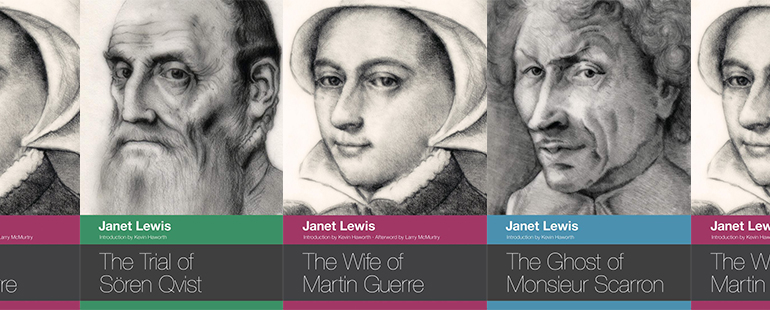The Case of Janet Lewis

Sometime in the early 1930s, the poet and literary critic Yvor Winters gave his wife, Janet Lewis, also a writer, a gift that would consume her attention for the next twenty-five years. It was a tome from the 1800s entitled Famous Cases of Circumstantial Evidence: With an Introduction on the Theory of Presumptive Proof, by the legal historian Samuel March Phillips; Winters had stumbled on it while drafting a 103-page pamphlet in defense of his friend David Lamson, a colleague in the Stanford English department who’d been accused of murdering his wife. When Lamson was sentenced to hang at San Quentin State Prison on the basis of rather scanty—yes, you guessed it—circumstantial evidence, the case became a national phenomenon, and its numerous appeals electrified the small community Winters and Lewis inhabited in what was then a largely rural, agrarian Palo Alto.
Despite Winters’s staunch advocacy for Lamson—who claimed his wife had fallen in the shower and struck her head, and ultimately was acquitted after three retrials resulted in hung juries—he must have recognized that the circumstances of the case had a certain literary flair, because the gift was intended to kickstart his wife’s writing. Lewis, already a successful poet who’d published alongside luminaries such as Ernest Hemingway (a high school classmate), William Carlos Williams, and Marianne Moore, had been struggling to write fiction, complaining that her stories lacked satisfying plots. Her husband thought Phillips’s book of historical case studies from the 1500s to 1700s might be of use. Winters was righter than he could’ve anticipated. Over the next two-and-a-half decades, Lewis would refashion the real-life episodes from Famous Cases of Circumstantial Evidence into three of the most striking and original historical novels of the twentieth century: The Wife of Martin Guerre from 1941, The Trial of Sören Qvist from 1947, and The Ghost of Monsieur Scarron from 1959, all adapted from chapters of Phillips’s book, and all centering on, in Lewis’s words, “failures of justice because of undue reliance on circumstantial evidence.”
In a 2011 essay for the London Review of Books, Perry Anderson argues that you can divide historical novels into two camps: “classical” historical novels of the 1800s, exemplified by Walter Scott’s Waverley or James Fenimore Cooper’s The Pioneers, in which “representative human types . . . [stage] a tragic contest between declining and ascending forms of social life”; and “postmodern” historical novels from the 1960s onward, exemplified by Toni Morrison’s Beloved or Gabriel García Márquez’s One Hundred Years of Solitude, in which classical conventions are overturned and the historical material is used to reexamine the present via techniques such as historical revisionism, counterfactuals, and meta-commentary. Conspicuously absent from Anderson’s schema are the interwar and postwar modernist years during which Lewis wrote her Circumstantial Evidence books. Modernist literature, Anderson claims, with its emphasis on the “primacy of immediate perception,” was incompatible with the “totalizing retrospect” necessary to write a historical novel. The only midcentury exceptions Anderson can think of are aesthetically “lightweight” books, such as Margaret Mitchell’s Gone with the Wind or Robert Graves’s I, Claudius—novels heavily tinged with nostalgia, aimed at satiating readers’ desire for escapism in difficult times.
Lewis, however, was neither a modernist nor a nostalgist, and was a far cry from a lightweight. Indeed, according to New York Times obituary writer Robert McGill Thomas, Jr. (Lewis passed in 1998), “there are many who will assure you that when the literary history of the second millennium is written at the end of the third, in the category of dazzling American short fiction her Wife of Martin Guerre will be regarded as the twentieth century’s ‘Billy Budd’ and Janet Lewis will be ranked with Herman Melville.” This may be something of an overstatement, but there’s no question that Lewis’s Circumstantial Evidence books represent major contributions to the midcentury canon that remain astonishingly unheralded, perhaps in large part due to the difficulty of pinning them down. They don’t read like any historical novel I’ve encountered. While Lewis clearly has a deep affinity for the material circumstances of the past, her books don’t marinate in historical minutiae, and they seem to have little interest in engendering a sense of identification with their protagonists. Although as readers we’re invited to peer into the lives unearthed by Phillips’s case studies, Lewis never pretends her prose can conquer the insuperable distance between us and them. The effect is like squinting at a palimpsest or wading through the archives of a dim library. You can see what’s been thrown up by the archivist’s candlelight, but you can’t look beyond the shadows.
Like many readers, my favorite book of Lewis’s trilogy is The Wife of Martin Guerre. In contemporary terms you might describe it as a novel about gaslighting, but that hardly does justice to its deeply ambiguous and highly suggestive plot. The earliest of the books in chronological terms, Martin Guerre is set in sixteenth-century France, and its protagonist is a young woman named Bertrande de Rols living in a small town at the foot of the Pyrenees. At the age of twelve, Bertrande is married to Martin Guerre, the son of a local farmer. Although he’s a young child like Bertrande, he has a stern, possessive personality, and is given to bouts of abuse. Soon after reaching adulthood and conceiving a child with Bertrande, he gets in a fight with his father and impetuously quits the farm, telling Bertrande he’ll return when the argument simmers down. Years pass, however, without any news of him. His father dies, and Bertrande is left to tend the land alone with Martin’s sisters and an elderly uncle. Finally, one day, a man resembling Guerre, described by Lewis only as a “bearded figure,” shows up at the farm. The scene is a marvel of compacted tension:
It was dark at the far end of the room. Bertrande stood in the sunlight and met, as in a dream, the long-anticipated moment, her breath stilled and her heart beating wildly. The figure in leather and steel advanced with even tread, a stockier figure than that of the man who had gone away eight years before, broader in the shoulder, developed, mature. The beard was strange, being rough and thick, but above it were eyes like those of Martin, the forehead, the whole cast of the countenance, like and unlike to Bertrande’s startled recognition, and as he advanced from the shadow he seemed to Bertrande a stranger.
The horror of The Wife of Martin Guerre—spoiler alert—is that the bearded figure is a stranger, an impostor with an astonishing resemblance to her departed husband. After serving in the Spanish military alongside Guerre and repeatedly being told of their uncanny resemblance, he has decided to move to Guerre’s hometown and take over the life Guerre has abandoned. But no one in Bertrande’s adopted family is willing to admit this. In the patriarchal culture of sixteenth-century Gascony, lacking a master to oversee the farm is akin to a financial death sentence, and Guerre’s sisters are happy to delude themselves into believing the impostor is their brother if it means familial security. The giveaway for Bertrande, who initially tries to go along, is that the new Martin Guerre is simply too nice. He is too considerate a lover, too caring to his adopted son, too dedicated to the farm and its wellbeing. Eventually, she reports her suspicions to a local magistrate, and a snowballing series of events leads to a trial being launched to prove the impostor’s identity. In a shocking turn, the real Martin Guerre, hearing word of the trial, shows up to reclaim his wife, leading the impostor to be hanged and burned in front of the Guerre home. After the trial, returned to her abusive husband, Bertrande is left to wonder whether she shouldn’t have simply gone along with the imposture in the first place, accepting an admittedly imperfect accord but at least a life of “peace and obscurity.”
The next two books in the trilogy, The Trial of Sören Qvist and The Ghost of Monsieur Scarron, also center on major public trials, featuring credulous protagonists victimized in agonizing fashion while an entire social milieu watches, judges, and records for posterity. In Sören Qvist, a seventeenth-century Danish pastor is accused of murdering his gardener after a mutilated body is found buried in his backyard. Although he initially believes himself innocent, the mass of circumstantial evidence pointing to his guilt provokes him to confess to the crime and accept a death sentence, thinking he must have committed the murder in a fit of blind rage. Twenty years after his execution, residents of the town discover that Qvist didn’t commit the murder; he was framed by a vengeful neighbor. Similarly, in Monsieur Scarron, an eighteenth-century Parisian bookbinder, Jean Larcher, is found with a libelous stack of pamphlets about Louis XIV. Thinking it must belong to his teenage son, he accepts responsibility for them, meaning death by hanging. Only on the day of his execution does he realize the pamphlets were planted by his apprentice, a young man from the provinces who has managed both to seduce Larcher’s wife and execute a plan to make off with his coveted bookbinding license.
In all three novels, although the plots are resolved by extremities of human malefaction verging on the lurid, the lasting aesthetic sensation is one of unease and disquiet, a kind of chilly contemplation of the strangeness, brevity, and imponderable contingency of human life. One can’t help but think of Lewis and Winters’s friend David Lamson, who, after being acquitted for murdering his wife, married a Hollywood screenwriter and settled down in the Palo Alto area, living in close proximity to Lewis into the 1970s. Either Lamson was a victim of a terrible accident that nearly led to his execution, or he was a stone-cold killer who got away with murder and deceived his closest friends. Both scenarios are chilling to contemplate, yet the truth is ultimately lost to the sands of time. This impenetrability, the veil between reality and our ability to circumscribe it within meaning and law, is conveyed through the style of Lewis’s prose as much as the content of her true-to-life stories. She is loath to enter the interiority of her characters; there is an incantatory quality to her writing and her patterns of attention that one can only describe as scriptural in tone, a kind of depersonalized omniscience.
Simply by virtue of association, Lewis’s work has often been linked to the school of poets and novelists circling around her husband, a cult figure whom acolytes dubbed the “sage of Palo Alto.” Winters was a scholar of the Renaissance who wrote fierce literary criticism decrying what Perry Anderson described in his LRB essay as the “primacy of immediate perception” in modernist writing. The notion that prose should mimic the chaos and disintegration of modern life, à la James Joyce’s Ulysses, was something he termed “the imitative fallacy”; good contemporary writing, he argued, should strive for “formal perfection” while privileging lucid analysis and sober reflection about “the condition of uncertainty.” Good writing, however, was something he believed to be in short supply among his contemporaries. Although an impressive roster of midcentury writers cited him as a major influence—in a 2018 piece for the New Yorker, Leo Robson argued you can construct a counter-canon of twentieth-century American literature by assembling the writers Winters inspired, ranging from John Williams (the author of Stoner) to U.S. Poet Laureates Robert Hass, Robert Pinsky, Philip Levine, and Donald Hall—the only contemporary novelists he claimed to esteem were his college friend Glenway Wescott and his wife.
I’m no scholar of Winters, but I’m not convinced his ideas are the best lens for evaluating Lewis’s work. Much of Winters’s writing focuses on poetry and its search for the proper form and register to render an image in nature; the prose work that most embodies the Wintersian aesthetic, Stoner, is a largely plotless novel about the evolving tastes and discrimination of an emotionally alienated professor. Lewis’s Circumstantial Evidence books share a certain aloof quality with Stoner, as well as an eye for the revelatory image, but they lack the historical reverence and equanimity that seem endemic to the Wintersverse—a worldview according to which the English language reached its expressive peak in the years preceding Shakespeare. All three of the Circumstantial Evidence novels are set in the confounding era between 1500 and 1750, a time when feudal European life was truculently ceding ground to modernity, and they portray history as a brutish and arbitrary thing, a grand churning that leaves maladapted victims floundering in its wake. What resonances emerge between the modern and medieval worlds tend to be disquieting and unsettling, rather than illuminating or rousing. In their focus on murky trials from the distant past, the novels are chock-full of the rituals of evidence and deposition we recognize from contemporary courtroom dramas, yet by culminating in gruesome public death sentences, they problematize the violence underlying our collective forms of justice and meaning-making, the incommensurability of our desire for abstract fairness with the messy unreliability of human subjectivity. A more accurate reading may be to view Lewis’s novels as a kind of Foucauldian “genealogy” avant la lettre, excavating the primitivism inherent in modern, so-called liberal systems of governance three decades in advance of Discipline and Punish.
Both Martin Guerre and Monsieur Scarron end with a disorienting zoom-out, directing readers’ attention to the blankness of the historical record after the cases that have thrust their protagonists into the spotlight. “Of Martin Guerre,” Lewis writes, “nothing more is recorded, whether he returned to the wars or remained in Argues, nor is there further record of Betrande de Rols, his wife.” A verdict having been rendered and what’s available in the public record having been expunged, Lewis exits the scriptorium and leaves us basking in uncertainty. One is tempted to draw a comparison with Lewis’s own situation as an overlooked twentieth-century master, abandoned to an unjustly obscure fate. Fortunately for her admirers, there are twenty-two boxes of her papers sitting in the Stanford University library, waiting patiently for the right archivist to come along and unearth them.



